With so many businesses competing for prospects, finding ways to stand out from the crowd is essential.
That’s why lead generation should be one of your priorities if you’re a business owner. After all, every sale you make begins with a lead.
That said, you can create an effective lead-generation strategy with the right information at your fingertips.
In this article, I compiled the most essential lead generation statistics that can help you make effective sales and marketing strategies.
Let’s begin.
Definition of Lead Generation Statistics
Before discussing the most important lead generation statistics, let’s define the terms.
What Is a Lead?
A lead is any individual showing interest in the products or services of the company. Leads are part of a larger cycle that transforms visitors into customers.
However, not all leads are equal. Here are the different types of leads you need to know.
Marketing Qualified Leads (MQL)
Marketing-qualified leads are contacts who engage with the marketing and sales teams’ efforts.
They could have submitted contact information, opted into a program, or repeatedly visited a website.
However, these qualified leads are not yet ready to receive a sales call. MQLs are not yet sales-ready leads.
Sales Qualified Leads (SQL)
Sales qualified leads are those that show interest in becoming paying customers. It is now up to the sales team to convert them into potential customers.
An example of a sales-qualified lead is someone who fills up your form to learn more about your service.
Product Qualified Leads (PQL)
These people have used your product and shown interest in becoming customers. These leads have used your free trials and consumed other marketing efforts.
A more specific example is someone who uses the free trial but constantly asks the sales team about other features.
What Is Lead Generation?
Lead generation is the process of trying to attract potential customers. It involves increasing their interest through lead nurturing.
You can find the lead generation process between attention and conversion.
The lead generation process revolves around the company’s steps to convert people into customers.
Some examples of lead generation marketing are coupons, in-person events, online content, content marketing, and job applications.
Sales teams are responsible for generating leads unless the company has a team whose sole job is to generate leads.
Generating leads is at the top part of the sales funnel. Sales teams should value quality leads over random new leads.
What Are Lead Generation Statistics?
Lead generation statistics are any quantitative data related to generating leads.
They can help you formulate better lead-generation strategies and run successful marketing campaigns.
Lead Generation Statistics
Here are some of the most important trends and statistics about lead generation.
61% of Marketers Say Their Biggest Challenge Is Lead Generation.
Lead nurturing and lead generation is very difficult. This is why you need a good lead generation strategy for your lead generation efforts.
Some marketers learn how to generate leads through trial and error.
Although this is common practice, there are more efficient ways, like learning about the market, using lead generation tools, and content marketing.
Source: HubSpot
53% of Marketers Say Lead Generation Takes At Least Half Their Budget.
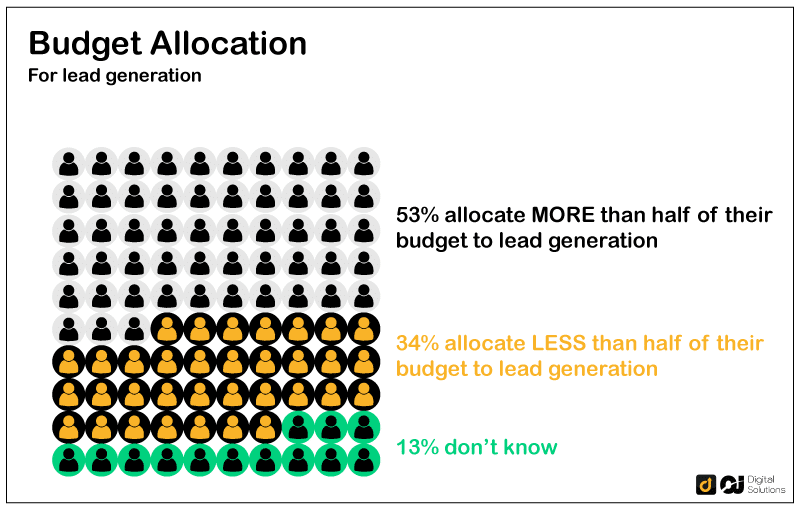
Marketers generate leads the best when they have the right tools.
Unfortunately, these tools are one of the reasons why lead generation is expensive.
Aside from lead generation tools, content marketing takes a lot of effort. You can do this yourself, but you have to outsource if you want to get more leads.
The good thing about outsourcing or buying lead generation efforts is it frees up the marketer’s plate. The marketer can then focus on lead nurturing, content marketing, and other marketing campaigns.
Some businesses prefer to have in-house lead generation for their content marketing.
However, this does not guarantee more leads because the lead quality will depend on the in-house team’s skills.
On the other hand, lead generation companies specialize in generating more leads. They have tested and proven strategies for effectively generating leads.
Source: BrightTALK
18% of Marketers Believe Inbound Lead Generation Is More Effective.
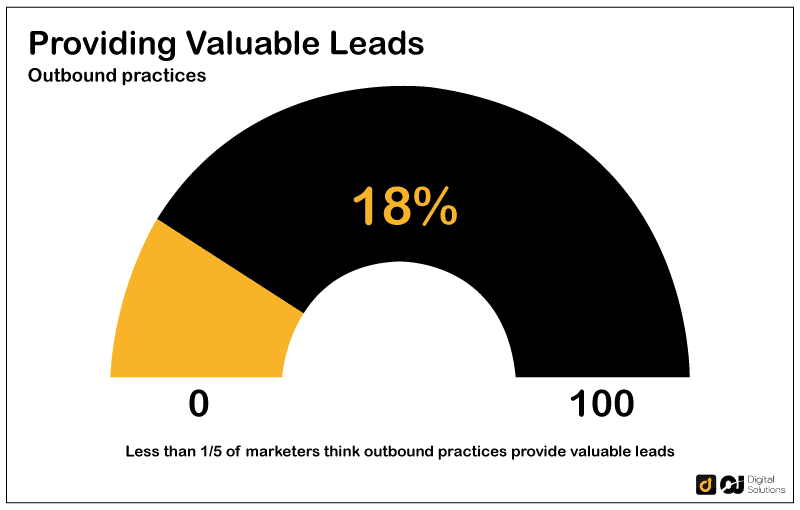
Only 18% of marketers think outbound lead generation practices give the highest lead quality.
Thus, outbound lead generation is becoming less and less popular. More companies now focus on nurturing inbound leads instead of allocating time and money to outbound prospects.
Source: HubSpot
80% of Marketers Think Marketing Automation Improves Lead Gen and Conversions.
Marketing departments believe the right automation marketing tool can improve lead gen by automating routine lead-gen processes.
One example is posting on social media.
Social media is a huge leverage to help you gather warm leads. With automation, social media marketers can focus on more pressing tasks.
Automation also makes scaling more manageable.
Leads Are 9x More Likely To Convert if You Reply in 5 Minutes or Less.
High-quality leads don’t waste their time. If you leave qualifying leads unanswered for too long, they tend to lose interest.
Lead scoring is best if you can reply to queries in 5 minutes or less.
Thus, businesses need a social media chatbot or social media sales reps to nurture leads that come from inquiries.
If you cannot afford sales reps, you can automate replies on your social media platforms. Ideally, you should have social media and website chatbots and email auto-replies.
Source: Ziff Davis
Outsourced Lead Generation Gives 43% Better Results Than In-House Lead Generation.
Outsourcing lead generation provides you with better results because you buy services from businesses focusing purely on lead generation.
In-house generation can work only if you have the experience, skill, resources, and budget.
If you outsource lead generation, lead qualification becomes their top priority.
Source: Fearless Competitor
66% of Marketers See Good Leads Even if They Only Spend Six Hours Weekly on Social Marketing.
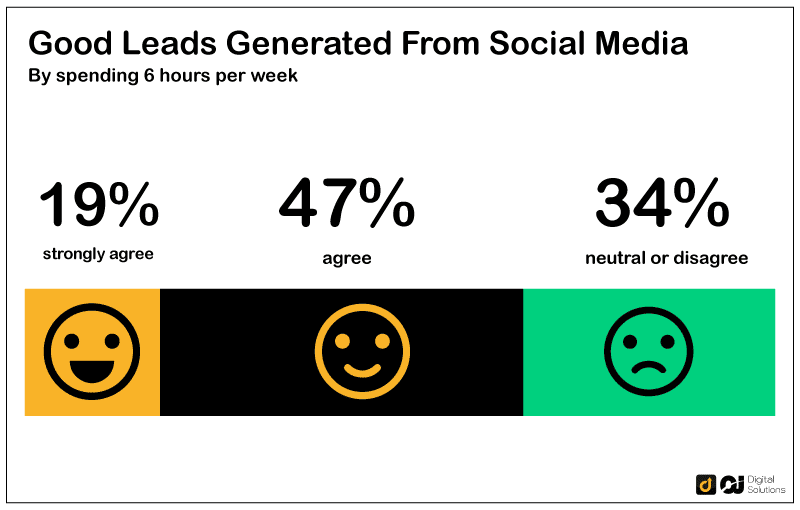
If you have a solid strategy, you can see good results on social media in less time.
If you are still starting out, your top priority should be to create a sound strategy around key metrics. These metrics involve hitting the target audience and converting them into leads.
Non-nurtured leads are a waste of time. Although you might have existing customers, you could still lose them if you fail to nurture them.
Social media users are fast and prefer to avoid delays. Because of this, you have to optimize your buying process to make it easier for anyone that wants to purchase from you.
Source: Social Media Examiner
LinkedIn Is the Best Channel for B2B Lead Generation.

LinkedIn is the best way to get prospective leads for B2B. Marketers in the B2B industry tend to favor LinkedIn compared to other social media.
Compared to other social media, LinkedIn users are more open to proposals. 45% of marketers had successful lead gen from LinkedIn.
LinkedIn gives a more modern approach to traditional email marketing. Marketers use LinkedIn as a less invasive way to approach potential leads.
You can find corporate decision-makers on LinkedIn. Most of the time, professionals use LinkedIn to engage with the business or ask work-related queries.
Source: Oktopost
Content Marketing Is 3x More Effective Than Outbound Marketing at Half the Cost.
Outbound marketing is more expensive and less effective than content creation.
Lead generation has to be efficient. Unless you have the best outbound marketing scripts or techniques, you should choose a more efficient method.
You can continue your strategy if you’re good at outbound marketing and have high conversion rates. If not, it’s better to focus your efforts elsewhere.
Content marketing, on average, costs 62% less than outbound marketing. It’s also 300% more effective in lead generation.
Focus your efforts on creating good content instead of reaching out to customers. This will let you attract more potential buyers at a lower cost.
Source: Demand Metric
80% of B2B Businesses’ Lead Generation Strategy Relies on Content Marketing.
80% of B2B marketers say their top lead generation strategy is to focus on quality content.
In the B2B industry, expertise is very important. Because of this, marketers create content to showcase their expertise and experience.
Instead of chasing clients, the lead generation strategy is to attract them by showcasing expertise in a field. Clients will most likely trust you if they know you’re an expert.
The main question businesses ask in the B2B world is, “How can I benefit?”
If you’re selling a product that aims to help businesses improve, focus on content that shows your expertise, shares experience, and differentiates yourself from others.
Source: Content Marketing Institute
Effective Headlines Result in 5x More Traffic.
The better your headlines, the better your traffic. Effective headlines can increase your page traffic by up to 500%.
For example:
Don’t:
“This Product Will Help You Increase Your Sales And Earn More Money”
Do:
“How to Increase Revenue: What Product Can I Use to Increase Sales?”
Blogs with good headlines are effective not just for SEO but also for improving your brand.
Here are four things a good headline has:
- Summary – You have to summarize the subject matter. Make sure the reader knows what the article is about.
- A Hook – Say something that makes your article interesting. Make sure not to spoil the ending. An example of this is “5 Tips for Optimal Website Performance.”
- Straightforwardness – Avoid writing headlines that are too long or vague. Be straight to the point.
- Appeal to Emotion – Depending on the article, you can appeal to the reader’s emotions. An example of this is “5 Lead Generation Secrets for the Struggling Entrepreneur On a Budget.”
Source: Wired
42% of Companies Say Email Marketing Is the Most Important Channel for Lead Gen.
Some call email marketing a thing of the past, but almost half of companies disagree. That’s because replies from this campaign often come with more interest.
When someone replies to your email, it is usually because they are interested.
On social media, the audience tends to inquire without the intention to purchase. These are dead leads that don’t always result in successful conversions.
Some consider email marketing as a more genuine way to collect leads. You can also consider it one of the most time-consuming campaigns without marketing automation.
But with automation, companies can ramp up their email marketing campaign efforts.
Source: Strategic
Email Has the Highest ROI Compared to Other Tools.
For every dollar you spend on your email campaign, you can earn up to $42 back. This is an ROI of 4,400%.
This figure depends on your industry and the type of customers you are targeting. Some industries are less likely to respond to emails.
It’s best to first research the effect of emails in your industry before launching an email campaign. Having an email campaign with an ineffective email will not yield good results.
When creating your email strategy, consult a professional copywriter. An email copywriter will help you generate a high-converting email.
Source: Campaign Monitor
The Best Time To Email Is 1 PM.
To get the best results, send emails at 1 PM. If you have tools that help you email blast, activate them.
Manually sending hundreds of emails is nearly impossible, but with a marketing automation tool, you can send emails effectively at 1 PM.
A marketing automation tool lets you send multiple emails simultaneously with scheduling features to ensure they send at 1 PM.
Other effective times to send emails are 8 AM, 4 PM, and 6 PM.
Source: Optinmonster
The Best Days To Email Are Monday, Tuesday, or Wednesday.
The earlier you email, the better. Monday has the highest open rate of 22%.
That’s because Monday is when people return to work. If they get emails on Monday, they are still fresh and have a higher open rate.
When people return to work, one of the first things they do is check emails. If you send emails on Monday, they are less likely to end up with other unanswered emails.
Sending emails on Sunday is not a good idea, as most people don’t work on Sundays. Aside from that, emails that come in on Mondays tend to pile up and bury the emails they receive on Sundays.
Source: Campaign Monitor
Marketing Emails Have an Average Open Rate of 21.5%.
The rate of recipients opening emails is 21.5%, which is good because you’ll get a larger volume if you can automate your emails.
If you can automate emails and send 1,000 an hour at an open rate of 21.5%, 215 readers will open them. That’s not a bad statistic.
If you design your automation to scale even further, you can enjoy higher visibility with email marketing.
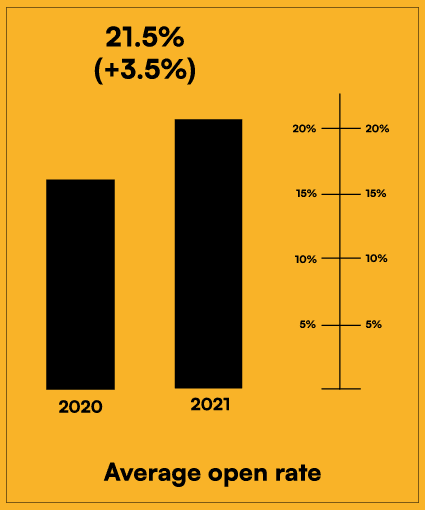
Source: Campaign Monitor
86% of B2B Businesses Use Landing Pages Strategically for Generating Leads.
B2B businesses design landing pages to help improve their lead generation and conversion.
A strategic and well-designed landing page generates better leads and is a technique B2B businesses use to increase conversion.
The advantage of a landing page is that you have complete control. You can position CTA buttons in a way that generates better results.
Once you have an effective landing page, you can continue to use it in your lead gen campaign.
The more landing pages you have, the higher your conversion rate optimization.
However, this does not mean putting quantity over quality. You must still ensure each landing page is effective.
Source: Marketo
Events Generate Better B2B Leads Than Other Campaigns.
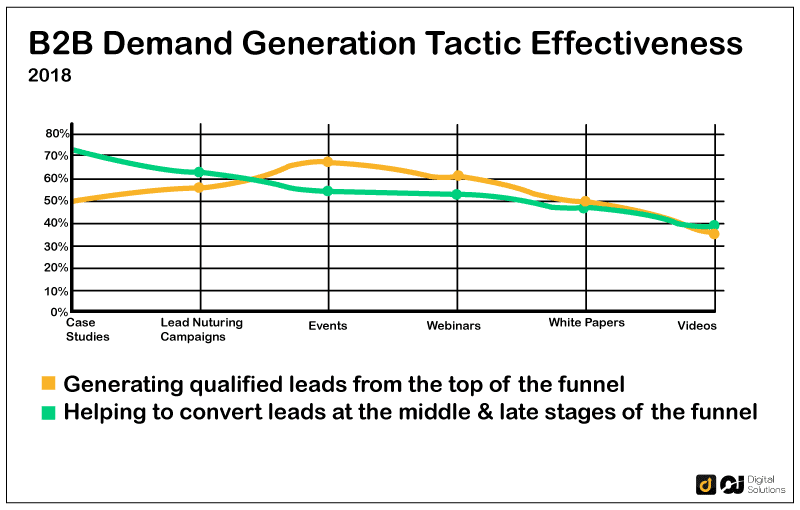
Events generate better B2B leads than case studies. Events are also better than videos, lead nurturing campaigns, webinars, and white papers.
In the B2B industry, trust is essential.
This is why businesses invest a lot in events that could cost millions of dollars but may be worth more with the leads it generates.
Businesses can use events to improve brand loyalty and foster better relationships with existing customers.
This method is more effective in B2B and a few other industries. An example of an event outside B2B with good lead generation and conversions is Comic Con.
Source: Marketing Charts
Lead Nurturing Results in 20% More Sales Opportunities.
You can generate 20% more sales opportunities by nurturing the leads you already have. This translates to higher profits.
The opportunity cost of not nurturing your leads is 20% in sales opportunities, which can result in a massive loss for businesses.
Nurturing leads doesn’t always take a lot of effort. Most of the time, it simply involves answering queries and providing information.
If you can take care of the leads you already have, you can increase your profits through additional sales opportunities.
Source: DemandGen
Nurtured Leads Spend 47% More Compared to Non-Nurtured Leads.
Nurturing leads is the process of building and reinforcing a relationship with buyers. This is important in every stage of the sales funnel.
The main goal of lead nurturing is to cultivate leads that are not yet ready to buy. Instead of just focusing on the leads ready to buy, you can entertain leads that might purchase, given the right push.
If you nurture your leads, you will see an increase in spending since people are more likely to buy if they feel comfortable spending.
An example of lead nurturing is welcome campaigns or educational campaigns.
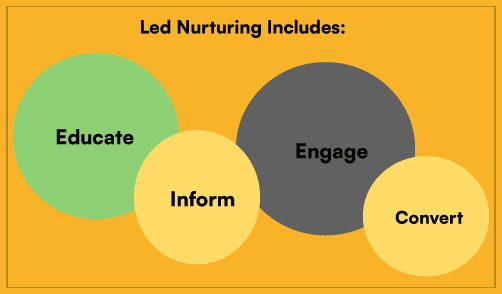
Source: Annuitas
73% of Leads Are Not Ready To Make a Purchase.
An average of 73% of all leads are not sales-ready, which is why lead nurturing is extremely important.
If businesses fail to nurture leads, they automatically miss out on 73% of their leads, leaving just 27% to entertain.
Leads that are not yet sales-ready get stuck at the top of the funnel. Your marketing team needs to engage with them more to move them down the line.
Once you learn how to nurture leads better, you will see faster funnel movement. The faster your funnel movement is, the more efficiently you can turn leads into customers.
Source: Marketing Sherpa
70% of B2B Marketers Say Video Content Improves Lead Conversion.
Over two-thirds of B2B marketers believe that video content improves lead conversion. That’s because videos are sometimes easier to consume than text.
Creating videos requires a one-time effort. Once you make them, you can reuse or repurpose them for your lead conversion.
Effective videos can include the business owner explaining the business or other content. Clients can also share their personal experiences with your products or services.
The more crafty you are with your video, the better.
Aim to produce high-quality ones since bad or low-quality videos can hurt your business.
Source: Content Marketing Institute
97% of People Ignore Cold Calls.
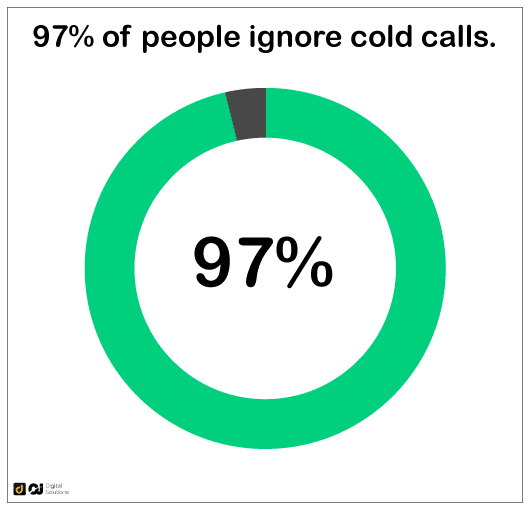
With 97% of people ignoring cold calls, you can consider this strategy extremely ineffective except on special occasions or in particular industries.
Even with qualified leads, cold calls are less effective than other methods.
However, the benefit of cold calls is that only some people do this, and if you decide to do it, you will stand out against competitors.
Just ensure you’re in an industry where cold calls are acceptable.
For example, cold calls for the real estate industry are widespread.
On the other hand, cold calls for cybersecurity and privacy aren’t that common.
Cold calling can be good for you if you learn to master it. You can use cold calling for high-ticket sales if you have expert salespeople.
Source: Business Wire
44% of Sales Reps Are Too Busy To Do Lead Follow-Ups.
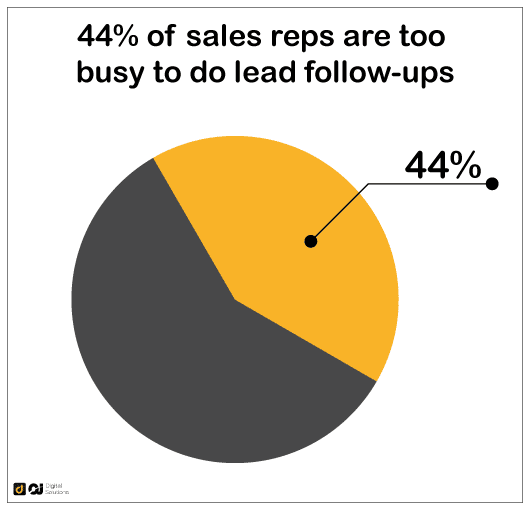
Almost half of sales reps do not follow up on their leads because many focus on getting more leads.
There should be a balance between getting more leads and converting leads you already have.
You can automate aspects of your marketing campaigns to focus more resources on following up with leads.
Lead follow-ups can be very effective for the business since some leads need that extra push to turn them into customers.
With a light follow-up, you get a higher likelihood of lead conversion. The beauty of follow-ups is that you can maximize the leads you already have.
Source: Verse
The Bottom Line
Knowing the latest lead generation statistics is crucial to turn high-quality prospects into sales.
Hopefully, this article has given you the necessary information to create effective lead gen strategies.
If you want more relevant business data, check out my guide on online shopping statistics.



